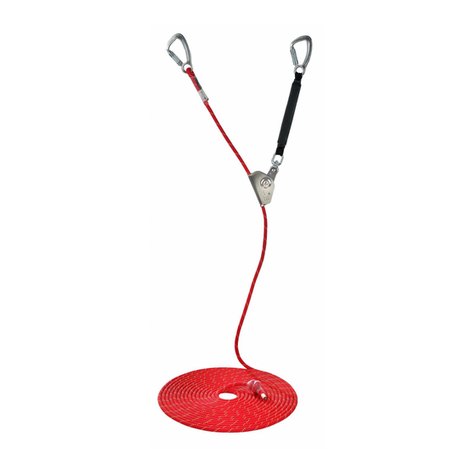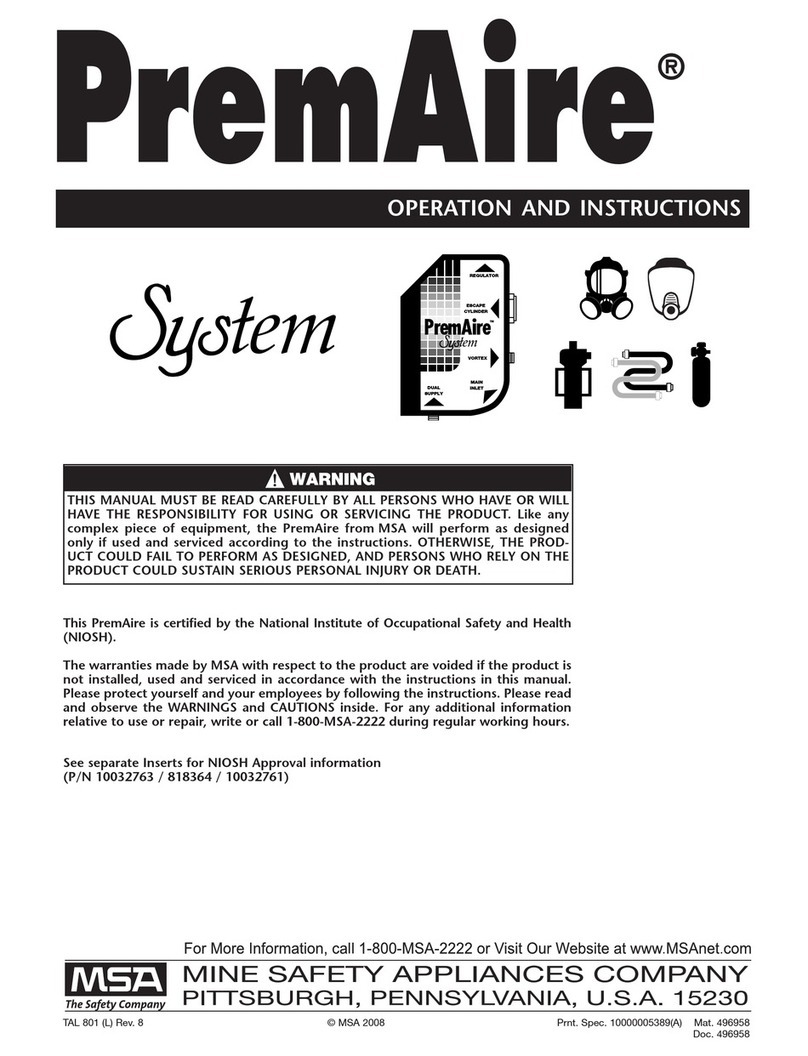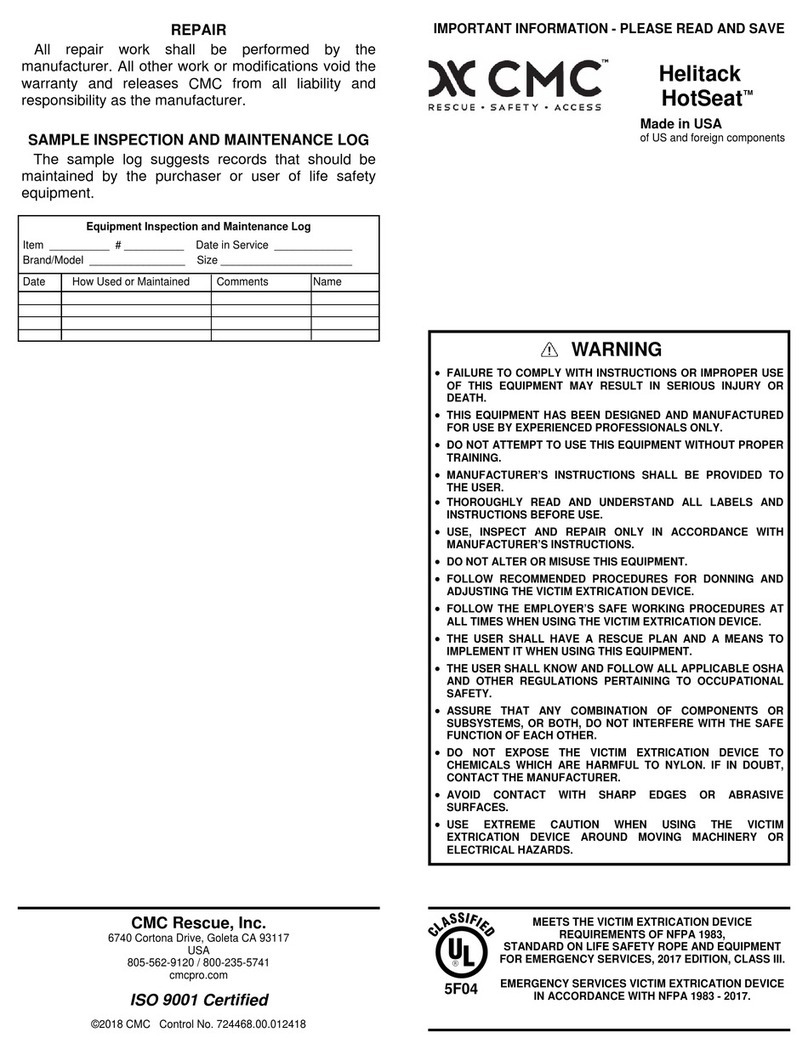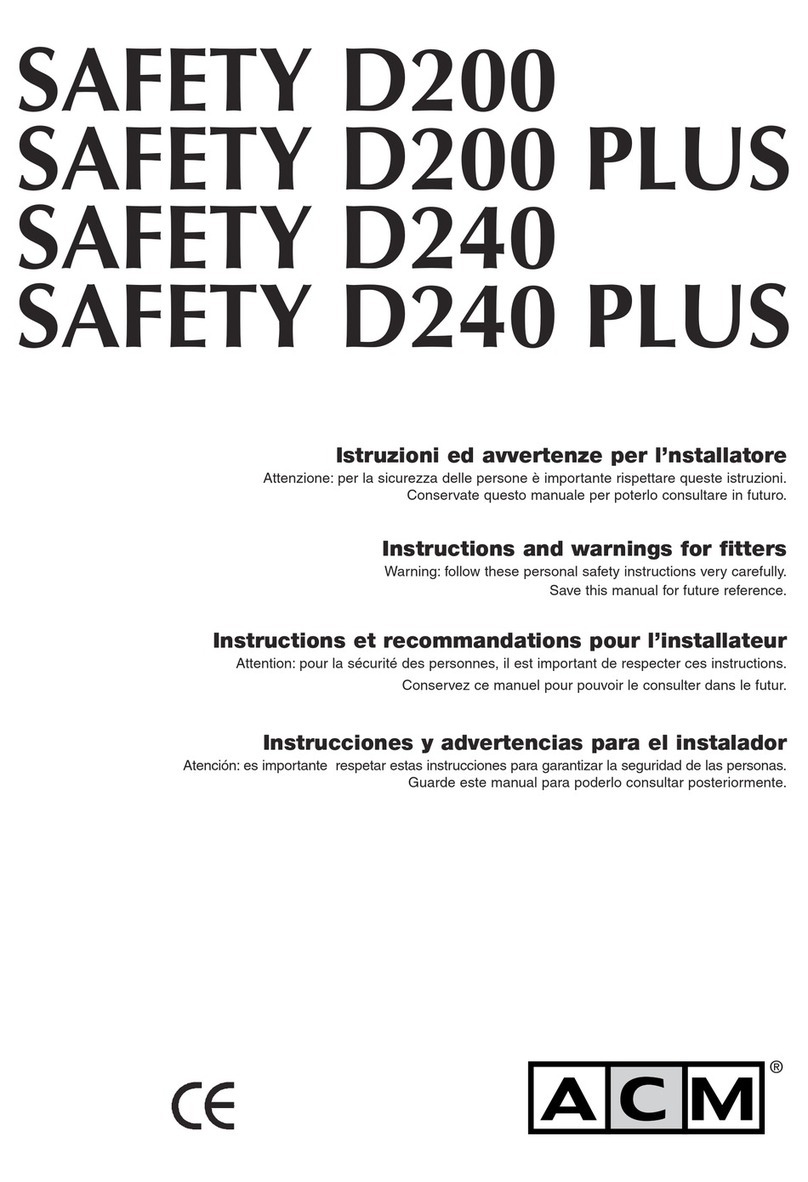Skitrab TR1 User manual

USER MANUAL
IMPORTANTE
Prima di qualsiasi utilizzo assicurarsi di aver compreso
integralmente quanto scritto in questo manuale d’uso.
IMPORTANT
Avant toute utilisation de ce produit, merci de bien
vouloir lire attentivement le contenu de ce mode d’emploi.
IMPORTANT
Before using this product please make sure that you have
read and understood the contents of the user manual.
WICHTIG
Vor dem ersten Gebrauch jeglicher Art vergewissern Sie sich,
den Inhalt des Handbuchs vollständig verstanden zu haben.

INTRODUZIONE
SKI TRAB vi ringrazia per aver scelto il suo attacco
TR1. Il TR1 è un attacco da scialpinismo sviluppato per
avere il massimo controllo in discesa, inoltre risulta
efficace e funzionale anche in situazioni di utilizzo
estremo.
La forza innestata in una struttura in metallo tiene
premuto lo scarpone contro lo sci azzerando i
movimenti dello scarpone tipici nei sistemi tradizionali
dove 2 spine si innestano centralmente nel tacco dello
scarpone, bloccandolo ma tenendolo in sospensione
e lasciando spazio tra tacco e sci. Mentre il bloccaggio
del TR1 a contatto con lo sci rende immediata la
trasmissione degli impulsi, massimizzando il controllo
e la risposta ai comandi.
Gli sganci di sicurezza regolabili sono laterali sul
puntale e frontale nel posteriore come i classici
attacchi da sci alpino.
La forza incrementale di serraggio del puntale
permette la camminata anche a leva sbloccata.
Bloccare lo sgancio su pendii ripidi e ghiacciati in fase
di discesa o sbloccare lo sgancio in salita in caso di
pericolo valanghe sono aspetti fondamentali della
sicurezza in ambito scialpinistico. Questo è possibile
solo con un numero molto limitato di attacchi; tra cui
il TR1.
Lo stopper è ad attivazione spontanea/automatica sia
in fase di salita che discesa
Il TR1 è estremamente funzionale e semplice nei
cambi di assetto; con il solo uso del bastone, senza
togliere lo scarpone, si passa dalla modalità di salita
a quella di discesa e viceversa. Questo permette
di scalettare o attraversare pendii con un maggior
controllo dello sci in fase di salita.
INDICAZIONI PRINCIPALI PER L’USO E SULLA
SICUREZZA
L’attacco TR1 è sotto tutti i punti di vista considerato
un attacco speciale, NON è conforme alla norma
internazionale DIN ISO 13992, le nostre scelte
tecniche , fatte per esaltare al meglio il controllo in
sciata, la duttilità di utilizzo in montagna non sono
compatibili con la suddetta norma. Quindi secondo
la normativa attuale l’attacco non risponde ad alcuna
normativa DIN ISO di sicurezza.
L’attacco TR1 è stato costruito per un utilizzo
comportamentale che tiene in considerazione diverse
esigenze dello scialpinista e necessità importanti per
gli sciatori esperti in ambiente di montagna, quali il
miglior controllo dello sci, la possibilità di scegliere sia
in salita che in discesa se tenere bloccato lo sgancio
del fronte scarpone e la possibilità di bloccare o
sbloccare il tallone dello scarpone senza togliere lo sci.
L’attacco TR1 ha sganci laterali e frontali regolabili in
base alla tabella SKI TRAB “RELEASE TR1”.
Ricordatevi che sciare è contemporaneamente
difficile e rischioso. E’ necessario essere consapevoli
che sciando, si corre il rischio di ferirsi. Un sistema di
attacco fra sci e scarpone non garantisce lo sgancio
in ogni situazione che potrebbe causare dei danni
alla persona e non può garantire che non si sganci in
altre situazioni causando infortunio dello sciatore. Per
questi motivi, con nessun attacco esiste una garanzia
assoluta di sicurezza.
Tanto più che lo scialpinismo si pratica in un ambiente
come la montagna dove i pericoli sono molteplici e
dipendono dai pendii, dal terreno dalla quantità e
tipo di neve, dall’instabilità della roccia e della neve
dove è assolutamente necessario conoscere la
montagna, le proprie capacità tecniche e i propri limiti,
le attrezzature da utilizzare e i limiti di queste anche
se costruite seguendo le migliori tecnologie e tecniche
disponibili.
Prima dell’utilizzo vi preghiamo di leggere
attentamente le istruzioni per l’uso.
AVVERTENZE DURANTE L’ IMPIEGO
Primadiagganciareloscarponeperlasalitacontrollare
di aver ripulito i fori nei quali si inseriscono le punte
dell’attacco. Controllare che le spine dell’attacco siano
correttamente inserite nello scarpone, se necessario
muovete e fate ruotare lo scarpone per accertarvene
prima di iniziare a camminare.
In salita, accertatevi che la leva di blocco dell’attacco
sia ruotata verso l’alto con gli indicatori di posizione in
WALK. Solo in questo modo lo scarpone è saldamente
bloccato all’attacco e lo sci non si sgancia.
In discesa, accertatevi che la leva di blocco sia ruotata
verso il basso con gli indicatori di posizione in SKI.
Solamente in questo modo si permette allo scarpone
di sganciarsi dallo sci riducendo il rischio di lesioni
durante una caduta.
Lo scialpinismo presenta situazioni dove un esperto
potrebbe utilizzare la leva di bloccaggio in modi
differenti da quelli normalmente consigliati per la
salita e discesa.
Con l’attacco TR1 possiamo valutare di camminare
con la leva abbassata in salita, consapevoli dell’utilità
che si possa sganciare lo sci in aree di valanghe o in
terreni poco ripidi e non esposti, o in discesa scendere
con l’attacco in posizione bloccata (leva ruotata
verso l’alto) consapevoli che l’attacco non permette
lo sgancio per esempio in terreni ripidi, ghiacciati o
esposti. Rimane assoluta responsabilità dello sciatore
decidere quale comportamento/modalità utilizzare.
ITALIANO
ITALIANO

Durante la sciata, un urto od accadimenti particolari
potrebbero modificare la posizione della leva frontale
del puntale. Verificare di frequente se la posizione è
quella corretta e voluta.
Accertatevi che lo ski-stopper sia bloccato durante la
salita.
Leggete con attenzione le modalità d’impiego con
illustrazioni
MONTAGGIO, REGOLAZIONE
E’ necessario che un rivenditore autorizzato provveda
al montaggio, alla regolazione, al controllo, alla
manutenzione e alla riparazione degli attacchi e degli
accessori dell’attacco TR1 SKI TRAB.
Il montaggio FAI-DA-TE è altamente sconsigliato.
Per un corretto settaggio e controllo degli sganci
frontali e laterali è necessario rivolgersi ad un centro
specializzato dotato di strumenti idonei e certificati
per la misurazione delle tarature di sgancio degli
attacchi da sci.
Si avvertono gli sciatori che:
-la corretta regolazione degli attacchi non costituisce
di per se garanzia di sicurezza per lo sciatore in tutte
le situazioni di sgancio o non-sgancio dell’attacco
durante la pratica dello scialpinismo.
-che questi prodotti non devono essere utilizzati con
scarponi da sci usurati o danneggiati.
-che sporcizia, conservazione o non utilizzo prolungati
o errati possono modificare il livello di sgancio
dell’attacco. Si consiglia durante il trasporto degli sci
su tetto della macchina di utilizzare apposito involucro
per proteggere l’attacco dallo sporco e dal sale.
E’ necessario verificare che sullo sci ci siano gli adesivi
che spiegano come riarmare il puntale in caso di
sgancio.
E’ consigliato sempre verificare sia dopo il montaggio
dell’attacco sia dopo l’uso, che la talloniera porti la
corretta pressione allo scarpone.
Si raccomanda di far sempre verificare, ad un
rivenditore autorizzato o a laboratori dotati di
attrezzature di misurazione sgancio attacco idonee e
certificate, l’attacco prima di ogni stagione sciistica o
comunque dopo uso frequente.
E’ necessario leggere modalità di impiego prima di
utilizzare il prodotto.
CURA E MANUTENZIONE
La garanzia concessa da SKI TRAB presuppone che
venganoosservatiiconsigli echevengaseguitoquanto
indicato. Inoltre bisogna far controllare regolarmente,
almeno prima di ogni stagione invernale, nei negozi
specializzati ed autorizzati il corretto funzionamento
dell’attacco.
Riporre gli sci e l’attacco in luogo fresco e asciutto,
lontano da fonti di calore dirette, gelo o intemperie.
Disporli verticalmente soletta contro soletta,
possibilmente sollevati da terra.
Accertarsi che sui componenti dell’attacco non vi
siano tracce di terra, fango,sale, sabbia o altre polveri
che possono favorire la corrosione e l’invecchiamento
dell’attacco stesso, danneggiando così anche i sistemi
di sgancio di sicurezza. In caso di sporcizia potete
lavare l’attacco con un getto d’acqua senza usare
l’alta pressione che potrebbe asportare il grasso sui
componenti. A fine lavaggio asciugare con cura le parti
metalliche.
Si raccomanda ogni anno prima dell’uso di effettuare
pulizia e lubrificazione dell’attacco sugli snodi e punti
di rotazione sia del puntale che del posteriore. Per la
lubrificazione si consiglia del grasso spray al silicone.
GARANZIA
La garanzia SKI TRAB viene concessa dal rivenditore
specializzato ed è valida per 24 mesi dalla data di
acquisto per eventuali difetti che possono essere
imputati ad errori di fabbricazione o a materiale
difettoso.
La garanzia è valida solo se la vendita, il montaggio,
la regolazione, l’assistenza e la riparazione sono stati
effettuati da un rivenditore autorizzato SKI TRAB.
Non sono considerati difetti e sono pertanto
esclusi dalla garanzia i danni che possono insorgere
dall’usura, dall’uso eccessivo ed improprio, da
influenze esterne come fuoco calore acqua ect. e dall’
inosservanza delle istruzioni di montaggio, di utilizzo
cura e manutenzione.
Per esercitare la garanzia, il servizio deve essere
richiesto tramite il rivenditore autorizzato
consegnando l’attacco o i pezzi presunti difettati e la
prova che l’acquisto è sotto garanzia.
Al ricevimento l’azienda SKI TRAB srl deciderà se
l’attacco o il pezzo di ricambio è difettoso e quindi se
ripararlo o sostituirlo.
Il diritto italiano è applicabile a tutte le controversie e
il foro competente è quello della sede della ditta SKI
TRAB srl.
ITALIANO
ITALIANO

ENGLISH
ENGLISH
INTRODUCTION
Thank you for choosing our SKI TRAB TR1 binding.
Tr1 is a touring ski binding designed to offer maximum
control in descent, besides being efficient and practical
even in extreme conditions.
The force generated by the metal structure grips the
bootfirmlytothe ski, eliminating the slippage common
with traditional pin binding systems where 2 pins are
inserted into the centre of the boot heel, blocking it
but keeping it suspended and leaving space between
the heel and the ski. Whereas the TR1 bond between
boot and ski ensures immediate power transmission,
maximising control and responsiveness.
The adjustable release systems, lateral on the toe
piece and frontal on the heel piece, are extremely
powerful and efficient like the classical alpine ski
bindings.
The incremental clamping force of the toe piece allows
the skier to walk even when the lever is unlocked. The
ability to lock the release on steep and icy slopes
during the descent or unlock it uphill in case of risk
of avalanche is essential for safe ski touring. This is
possible only with a very limited number of bindings,
including TR1.
The brake is automatically activated in both downhill
and uphill mode.
Easy and intuitive to operate. Using just a pole,
without releasing the boot, it is possible to switch
from uphill to downhill mode and vice versa. This
makes it possible to sidestep up or cross slopes with
a greater control of the ski even in difficult uphill
conditions.
INSTRUCTIONS AND SAFETY ADVICE
The TR1 binding is from many points of view a
specialised piece of equipment for ski touring. IT
DOES NOT CONFORM TO THE INTERNATIONAL DIN
ISO STANDARD 13992.
Our technical choices have been made to truly exploit
the full potential of the ski, offering full control while
skiing and functionality while on the mountain, and do
not fully comply with the aforementioned standard.
Therefore, according to the current standards,
the binding DOES NOT meet the DIN ISO safety
regulations.
The TR1 binding was designed for use in a variety of
situations and takes into consideration the different
requirements of the touring skier as well as the
important needs for the expert skier, such as better
ski control, the possibility to choose both in ascent
and in descent whether or not to keep the front boot
release locked and the possibility to lock or unlock the
heel of the boot without taking your skis off.
The TR2 binding has side and front releases which
can be adjusted according to the chart SKI TRAB
‘RELEASE TR1’
Remember that skiing is both difficult and dangerous;
it is important to be aware that there is a risk of injury.
A binding system between the ski and boot does not
guarantee that the boot will release in situations that
may cause injury or that it will not release in other
situations, again causing injury. For this reason no
binding can guarantee complete safety.
Ski touring is practised in a mountain environment
where there are a great number of dangers depending
on slope gradients, terrain, the quantity and type of
snow, and the instability of the rock and snow where it
is of fundamental importance to know the mountain,
one’s own technical abilities and limits, the necessary
equipment and its limits even when made using the
best technology and techniques available.
Before use please read the instructions carefully.
INSTRUCTIONS FOR USE
Before snapping the boot into the binding for an
ascent, check that the holes where the pins of the
binding are inserted are clean. Check that the binding
pins are correctly inserted in the boot, if necessary,
move and rotate the boot to make it sure before
starting walking.
For ascent, make sure that the blocking lever of the
binding is rotated upwards in the WALK position. Only
in this way the boot is firmly blocked by the binding
and the ski does not release.
In descent, make sure that the lock lever is facing
down in the SKI position – this is the only way to allow
frontal and lateral release in case of a fall, reducing the
risk of injury.
Ski touring sometimes presents situations where an
expert may use the lock lever in a different way to how
would be normally advised in ascent and in descent.
With TR1 binding the user can walk with the lever
facing down in ascent, knowing that the ski can
release in avalanche areas or on terrain that is not
steep or exposed; or in descent ski with the binding
locked (lever facing up) safe in the knowledge that the
ski will not release on steep, icy or exposed terrain. It
is the responsibility of the skier to decide how to use
the bindings.
When skiing, an impact or particular incident could

ENGLISH
ENGLISH
change the position of the frontal lever at the toe unit.
Check the position frequently to make sure it is the
same as it was set.
Make sure that ski brake is blocked during the ascent.
Read carefully the instructions for use, complete with
photographic illustrations, provided in this manual.
MOUNTING AND ADJUSTING
It is very important that mounting, settings, check,
repair or any required maintenance work for SKI TRAB
TR1 bindings and binding accessories should only be
carried out by an authorised dealer.
We strongly advise against mounting the bindings
yourself.
To make sure your bindings are correctly set and
checked, please go to a specialized vendor with
suitable, certified instruments for measuring ski
binding release settings.
Skiers are advised that:
- the correct binding setting is not in itself a guarantee
of safety for the skier in all situations of binding
release or non-release while ski touring
- these products should not be used with worn or
damaged ski boots
- dirt, storage, prolonged lack of use or wrong use can
affect the binding release. When transporting skis on
the roof of a car use an appropriate cover to protect
the binding from dirt and grit.
Check that the stickers explaining how to reposition
the front unit in case of release are on the skis.
It is advisable to check both after the binding has been
mounted, as well as after use, that the heel of the
boot applies the correct pressure on the boot.
We recommend always checking the binding before
every ski season or after frequent and/or intensive
use at an authorised dealer or lab with suitable,
certified instruments for measuring ski binding
release settings.
Please read the operating instructions carefully
before use.
CARE AND MAINTENANCE
The SKI TRAB guarantee works on the basis that
the instructions and recommendations for use are
observed. It is also necessary to check regularly
(at least at the beginning of the ski season), that
the binding is functioning properly at a specialised
authorised store.
Store skis and bindings in a cool, dry place away from
direct sources of heat, ice or the elements. Position
vertically with the base of the skis against each other,
if possible off the ground. Make sure that there are
no traces of dirt, mud, salt, sand or other grains that
could cause corrosion or wear to the binding and
damaging the safety release systems. If the binding is
dirty then it can be hosed down with water (do not use
a high pressure hose as this could remove the grease
from the components). After washing dry the metal
parts carefully.
Every year before use clean and lubricate the binding
around all joints and rotation points, both on the toe
piece and the heel piece. For lubrication use a silicone
grease spray.
GUARANTEE
The SKI TRAB guarantee, offered by specialised
dealers, is valid for 24 months from the date
of purchase for any defects that may be due to
manufacturing faults or defective material.
The guarantee is valid only if the sale, mounting,
setting, assistance and repair have been carried out
by an authorised SKI TRAB dealer.
Damage due to wear and tear, improper or excessive
use, external factors such as fire, heat, water etc.,
non-observance of the mounting instructions or
instructions for use and care and maintenance, is not
considered as a defect and is therefore not covered by
the guarantee.
In order to use the guarantee, the service must be
requested through an authorised dealer, consigning
the binding or parts presumed defective and proof that
the purchase is under guarantee.
When SKI TRAB receives the binding or the part they
will decide if it is defective and whether or not to repair
or replace it.
Italian law is applicable for all disputes and the
competent tribunal is that of the office of the company
SKI TRAB srl.
Table of contents
Languages:
Popular Safety Equipment manuals by other brands
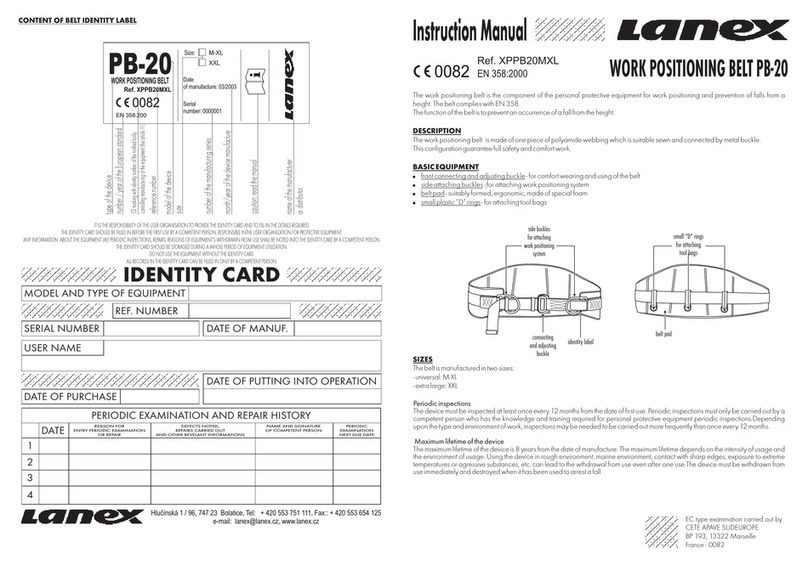
Lanex
Lanex PB-20 instruction manual
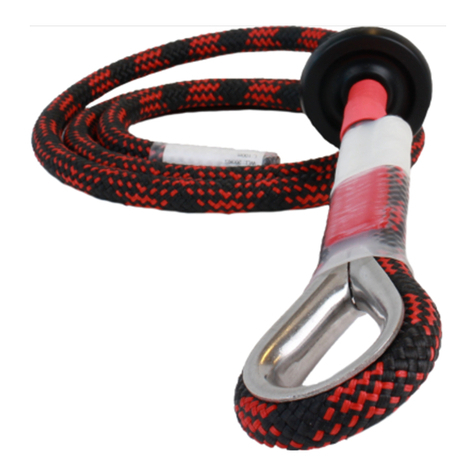
SKYLOTEC
SKYLOTEC ANCHOR ROPES Instructions for use

Besto
Besto Buoyancy Aid 50N Instructions for use

TEUFELBERGER
TEUFELBERGER NODUS Manufacturer's information and instructions for use

Troy Lee Designs
Troy Lee Designs Tbone Product owners manual
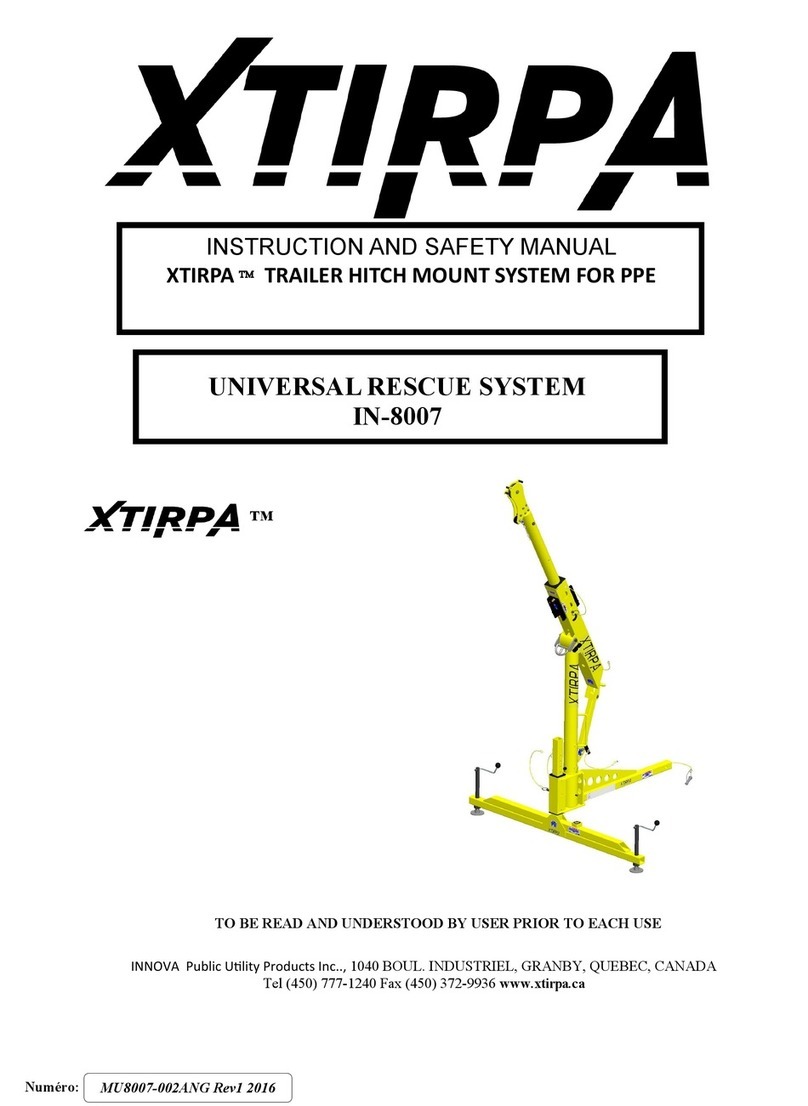
Innova
Innova Xtirpa Instruction and safety manual

bolle SAFETY
bolle SAFETY B810 quick start guide
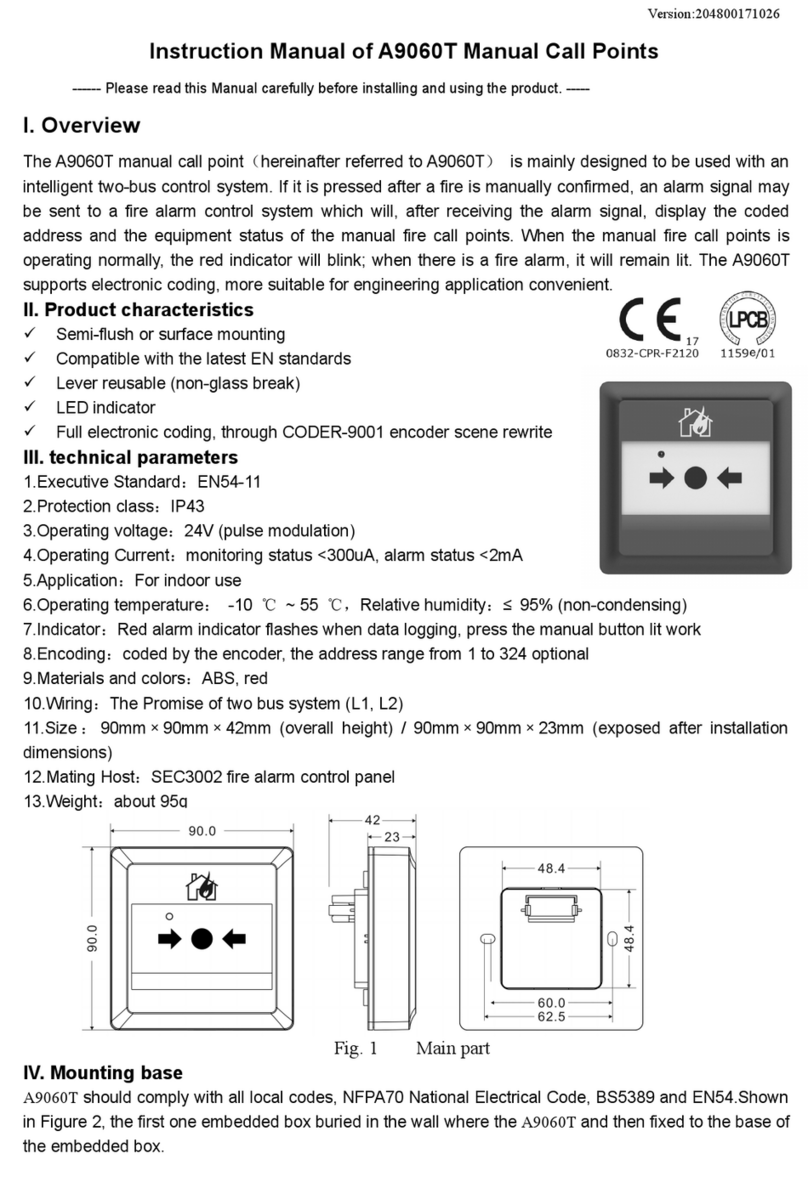
SHENZHEN FANHAI SANJIANG ELECTRONICS
SHENZHEN FANHAI SANJIANG ELECTRONICS A9060T instruction manual
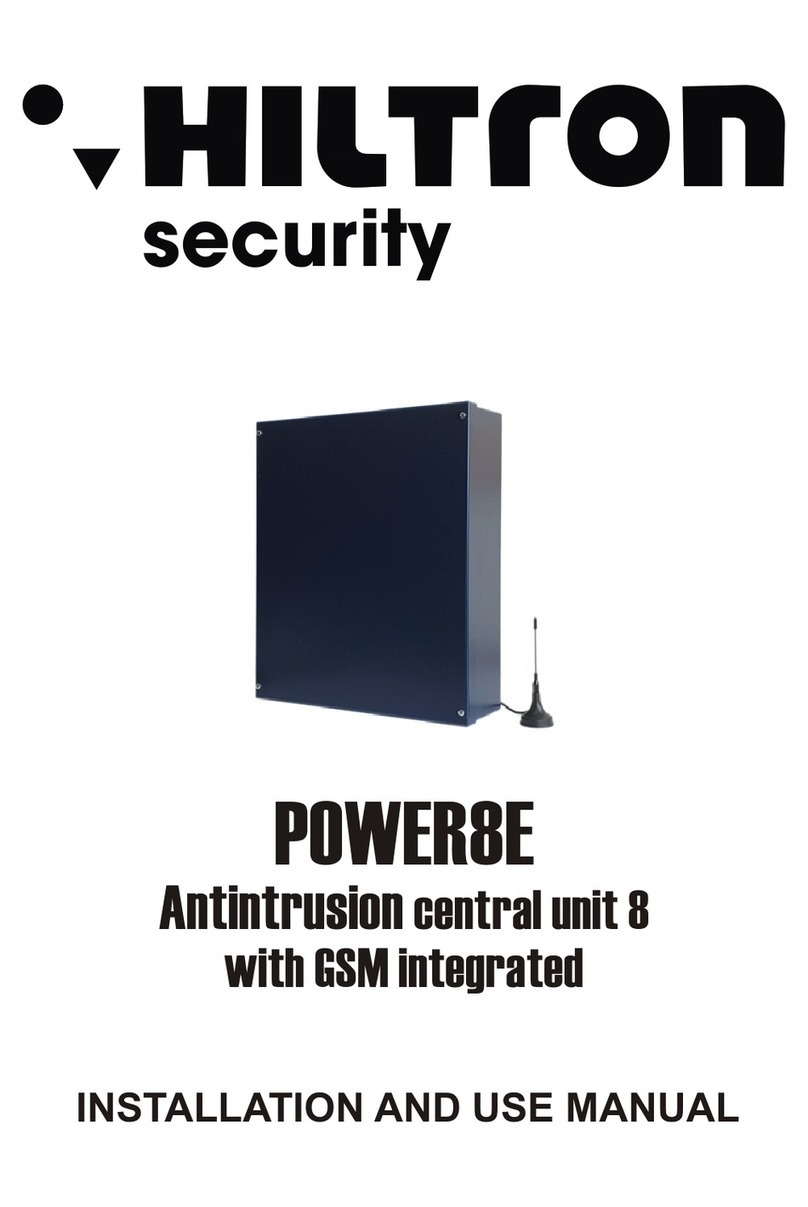
Hiltron security
Hiltron security POWER8E Installation and use manual

Salewa
Salewa MTN SPIKE user manual
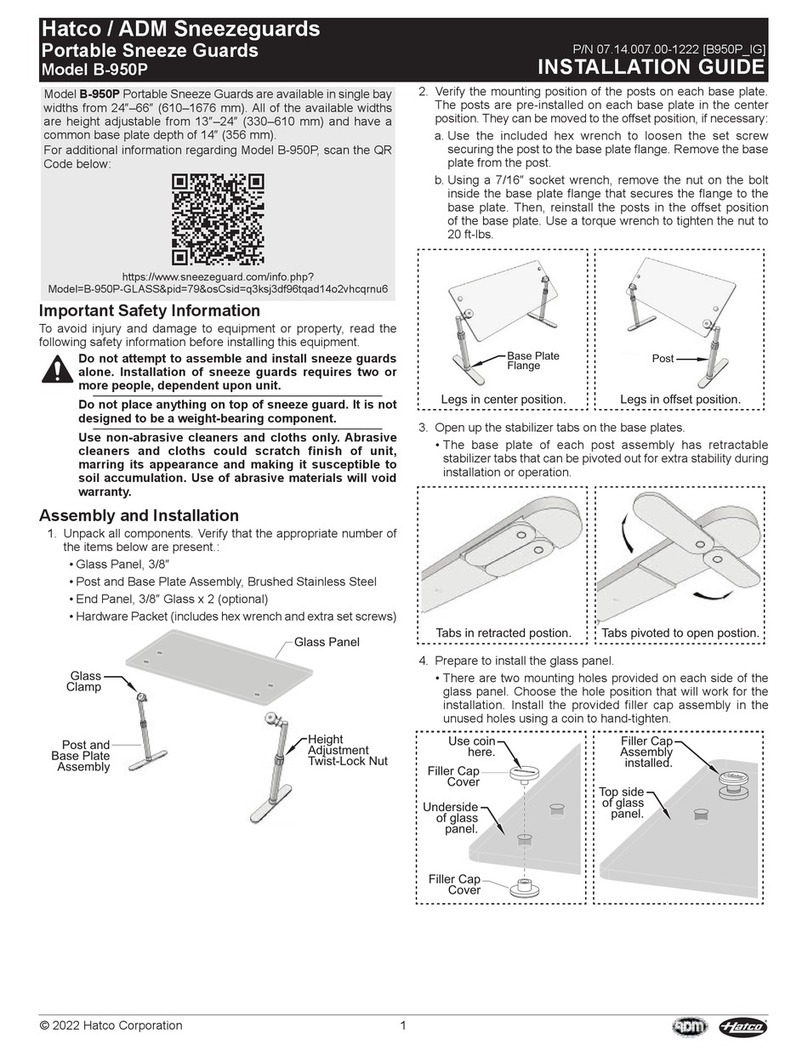
Hatco
Hatco B-950P installation guide
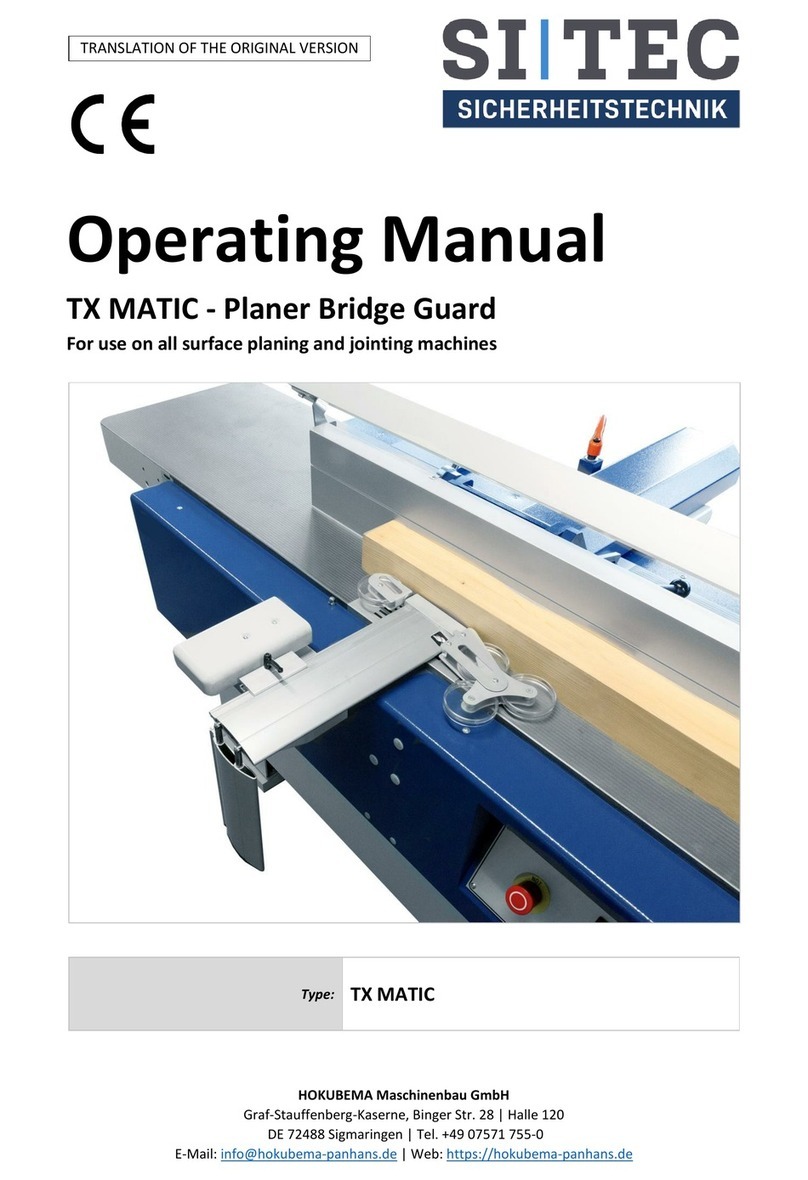
Sitec
Sitec TX MATIC operating manual
